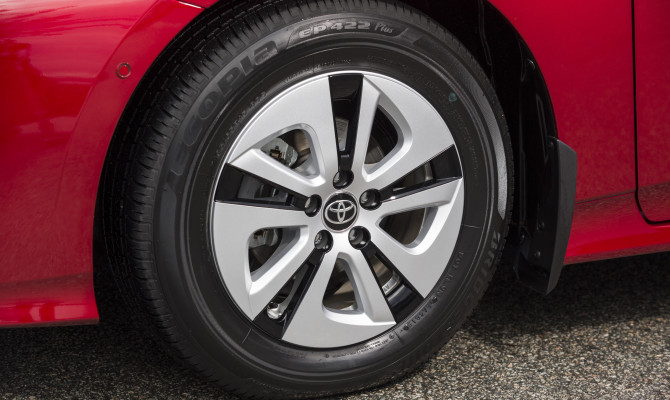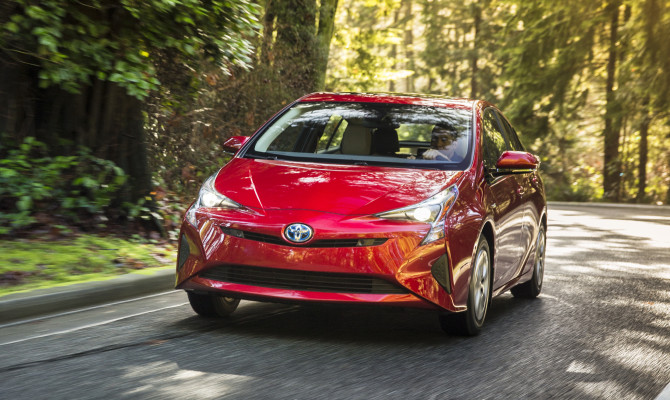No surprise the 4th generation is a hybrid but that fact undersells its other attributes.






It would be no more than an unimaginative statement of the obvious to describe the all-new 2016 Toyota Prius, as a gas/electric hybrid powered car.
Obvious perhaps because since its launch back in 1997 its nameplate has only ever been offered with a hybrid power unit. Clever marketing ensured Prius became synonymous with green driving and the badge showed all that owners were environmentally conscious. Since then, Toyota has sold more than 3.5-million Prius models largely on the strength of that green cred.
No surprise that the fourth-generation model is a hybrid but placing the emphasis on that fact is totally inadequate and undersells its other attributes.
The Japanese giant has not abandoned the trumpeting of the car’s green nature but it’s much more low key in its new marketing campaign. Instead, Toyota is trying to persuade potential buyers that this new version is ready to compete in the mainstream against conventional gas-powered sedans based on price, performance, technology, safety and, yes, looks!
Let’s get the latter point out of the way, right away. It has never been a looker but with its new sleek, lower stance it is as close to sporty as you are likely to get in a Prius. It appears to these eyes that red livery gives it a sharpest appearance but blue looks good too. Less enthused about paler renderings.
Toyota Canada vice-president Stephen Beatty says the brand wants to “break the cycle of psychology about gas prices fuelling hybrid sales.” At the risk of incurring the wrath of the Toyota marketing department (not that it would bother me), that’s going to be a tough sell. The 2016 edition achieves still more fuel economy gains and that will continue as a purchase persuader.
And the price is right, an equal driver of sales in my opinion: three trims starting at $25,995, which is $300 less than the outgoing third gen model.
Opening the doors reveals some things don’t change. As is the norm, the instrument panel is in the centre, which always takes me a few drives to get used to. What is different is the arrangement of the info screens, all the stuff you need to pilot safely features on a pair of side-by-side LED screens, which essentially form a single display, and that sits neatly above a larger infotainment screen separated by the heating vents.
The base console is an uninspiring black plastic but it’s replaced by an off-white colour on the other trims. That might take a time to grow on me.
The enlarged platform, smaller batteries and reconfiguration of where they sit, behind and under the rear seat translates into much more cabin room and a more comfy rear seat ride. (Incidentally, the base model keeps the nickel-metal-hydride units, whereas the top trim with a technology package used the lithium-ion battery.)
The Toyota Safety Sense system will be available on all but the base model: Pre-collision system, lane departure alert, automatic high beams, and dynamic radar cruise control.
A technology package will add blind spot monitoring and rear cross traffic alert, full-colour heads up display, an intelligent parking and warning system with 12 sonar sensors positioned around the vehicle. This will give the driver the opportunity to park – parallel or perpendicular – without laying a hand on the steering wheel. That’s what an additional $590 gets you along with heated front seats. Even the most loaded editions barely pass $33,000.
Promise I’ll get behind that wheel soon. The new Prius uses a revised version of Toyota’s 1.8-litre-Atkinson cycle engine. The official fuel economy numbers are not out yet but internal testing revealed a fuel efficiency of 4.5L/100KM (city/highway combined). The launch drive in Vancouver suggested the 4.5 number is far from being a dream.
Okay, we’re off. Normal and Power driving modes suggest this actually might be a fun drive. Normal errs on the side of economy-optimized performance. Power packs some fun into the Prius, without serious compromising fuel economy.
The car is a gem in the city as you would expect and spirited on the highway, especially when the Power mode is selected. To be fair, I didn’t feel the need to explore my inner Boy Racer too many times.
Looking forward to spending a week in the car when I can truly put it to the test in real world conditions.
Recent Comments
- { Enjoyed your Forest of Bowland in the BMW X5M, particularly the photo of the BMW in front of the main part of Stonyhurst College where... }
- { Bantam designed the Jeep, not Willy's or Ford. The American military gave the original Bantam prototype to Willys and Ford to copy. There is plenty... }
- { All Escalades come with a 6.2-lilter V8 engine that produces 420 horsepower. A six-speed automatic is the only transmission offered and drives the rear wheels.... }
- { Alexandra is an excellent journalist. }
Popular Posts
- Journey to a ‘Sparkling’ Luxury Okanagan Resort “Four lucky readers will put a Dodge Journey’s weekend-...
- The Need For Speed: Hike Those Highway Limits More than half of those polled believe the province sho...
- Drives-U-Crazy… Erratic drivers. An early morning drive from Kelowna to Vancouver is nor...
- Readers Respond: The Pros and Cons of Increasing B.C. Speed Limits Increasing the speed limits will only increase risk to...
- Honda CR-V Review: The Compact Crossover To Get Things Done The CRV is a very stylish and aerodynamic crossover veh...






